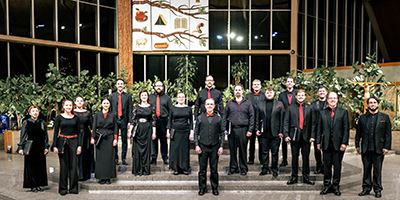by Daniel Hathaway

“Pater Noster” will feature seventeen settings of Christianity’s most famous prayer in six languages by known and anonymous composers dating from the last 400 years.
The Lord’s Prayer is the supplication that Jesus taught his disciples when they asked him how they should pray to God the Father. His answer is preserved in slightly different versions in two of the Gospels: Matthew 6:9–13 and Luke 11:1–4.
To learn more, I reached Jay White by telephone in his studio at Kent State University, where he had just celebrated the first balmy breezes of spring by opening all the windows.
Daniel Hathaway: How did you become obsessed with the search for settings of “Our Father?”
Jay White: (laughing) That’s a good way of putting it, isn’t it! Well, if you haven’t noticed the themes I’ve done in the past where I focus on a particular individual or a particular set of words — for example, the Magnificat — in this instance I was going through one of the common prayers we have in many Christian rituals regardless of denomination, and that would be the Lord’s Prayer. I was raised in Florida in the Methodist Church until I was 10, and if I remember correctly as a kid, we said the “Our Father” pretty much every Sunday.
It was one of the prayers that I learned first after “Now I lay me down to sleep” — that was the important one because you had to say all your family names. Of course I didn’t quite understand the meaning of it, but I knew how important it was to be part of something larger than myself, or to be included among the adults.
DH: I can bet what popped up early in your search.
JW: Of course — the Albert Hay Malotte setting, which is not in the Renaissance style that Quire tends to do. I did want to branch out into 19th- and 20th-century pieces but it was important that they be a cappella settings.
DH: You were successful in unearthing quite a list of repertoire. How did you turn that into a concert program?
JW: At first, I thought that I would arrange the pieces chronologically, but that didn’t quite work for the whole program. So I married some earlier and later settings based more on the sound.

JW: The biggest one was Giuseppe Verdi’s O Padre Mio. The score says it was popularized by Dante, and that was originally thought to be the famous poet Dante Alighieri, but turned out to be a different person of the same era, Antonio Beccari da Ferrara. It uses a conflated text that inserts more words into the original phrases. Verdi’s original intent was to have it sung by 300 people after his Requiem. It’s contemplative and a cappella, and sounds quite Verdian.
DH: Another interesting set begins with a Notre Père by Maurice Duruflé (1902 – 1986) and continues with Pater Noster settings by Cipriano de Rore (c. 1515 – 1565) and Francisco Guerrero (1528 – 1599).
JW: Those came together on the program because of the number of voices they use in context. The Duruflé is homophonic and chant-inspired. The de Rore is for five voices, the Guerrero four. Here I was thinking more about the soundscape.
DH: The first half of the program ends with a Pater Noster by Jacob Handl (1550 – 1591). Is that one of the polychoral works for which he’s famous?
JW: It’s polychoral, but unusually so. The tenors and basses form one chorus, the sopranos and altos another. Handl’s word painting is fascinating because everybody already knew the text.
DH: I also like the set that includes three very different versions: The Lord’s Prayer by Robert Stone (1516–1613), Our Father, which art in heaven by John Sheppard (c. 1515–1558), and Kittery (Our Father) by William Billings (1746–1800).
JW: That’s very fun. I had forgotten the tradition of stopping at the fermatas in the Stone, almost as you would in Bach chorales. And the Billings re-works the text into stanzas to fit the rhyming scheme of Kittery, an existing tune.
DH: And very topically, you’re ending with an anonymous 18th-century Kyvian chant (Otche nash), paired with a setting of Vater unser by the Liechtenstein composer Joseph Rheinberger (1839–1901).
JW: The Rheinberger, for two identical choirs, is the only piece in German, and is interesting for the way each section of the piece reacts to the text. General petitions bring all eight voices together at once.
DH: It’s quite an interesting program. Does it work?
JW: It works because it contains so many different sounds as well as preserving the individual sonorities of the composers.
DH: Last question: do you prefer “trespasses and trespassers” or “debts and debtors?”
JW: I like “trespasses” just because of the way it feels in the mouth.
Published on ClevelandClassical.com April 19, 2023.
Click here for a printable copy of this article



